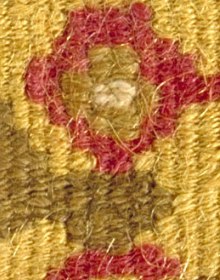let the objects speak
Chimú - Loin Cloth Fragment - In the Object's Own Words

Form
Around 600 years ago a Chimú weaver made me. Imagine that! I am so old, yet in such fine condition! Look for yourself at a close up view of my fine stitches! Examination of my construction tells of ancient traditions and the humanity of ancient peoples; specifically, how they used their hands and minds to create textiles. Andean weavers used a variety of techniques to form designs in the structure of the cloth itself. They combined technique and artistry to create motifs, such as my border of repetitive birds, which have a symbolic reality not fully understood today.
Function
People from the Andes rely heavily on textiles for survival and protection against the weather, as well as for spiritual needs. I am a panel from a large loin cloth and I was included in a mummy bundle. Many cultures bury the deceased with special goods. In general, cloth was made and treated with care and respect. The Andean people believed I possessed mystical attributes, especially when placed close to their bodies. Even the small figurines which were placed with the dead as votive offerings tended to be clothed and would not have been considered intact or complete without their attire.
Interment
All of the many steps and skills required to weave me speaks of my value and worth to my people and is reflected in the way they included me within an elite burial. You can see for yourself by examining the dark brown discolourations that I was interred as part of a mummy bundle. These are stains left behind by the decomposition of the ancient mummy I used to be wrapped around. Both the physical evidence of decay and my high quality of workmanship indicate my use an important funerary object.
Rediscovery
Sometime in the past 100 years, the ancient burial of an elite individual from Peru's north coast was disturbed. The rare and finely crafted contents of the burial, including me, were removed for sale at a time when such practices were not considered as objectionable as they are today. While I regret that my society's wishes for me to stay buried with my owner were not respected, I am glad now that at least I have found a home here at the museum where I am cared for, studied and now featured online so the whole world can learn from me about my people.